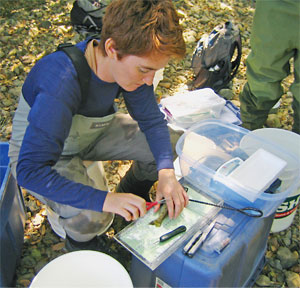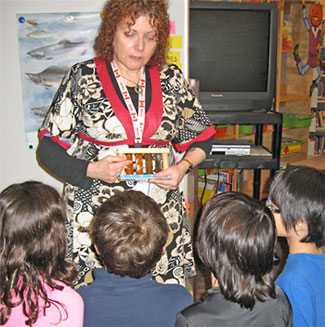Autumn 2010- Winter 2011
Alumni Updates
Stephanie Carlson
PhD 2006: The evolutionary effects of bear predation on salmon life history and morphology
Stephanie Carlson is an assistant professor in the Department of Environmental Science, Policy and Management at UC Berkeley, where she focuses on the evolutionary ecology of freshwater fishes.

Courtesy of Stephanie Carlson
Growing up in Sacramento, Stephanie spent a lot of time near the confluence of the American and Sacramento rivers, which she credits as influencing her career path. Biology was her favorite subject in school and, initially, she considered going into medicine. Indeed, as an undergraduate at UC Davis, she was on a pre-medicine track until Professor Peter Moyle lured her into fish ecology: “His enthusiasm was contagious and it is because of his passion that I changed my entire career direction.”
Stephanie’s work with Moyle’s group motivated her to attend graduate school: She said, “With each new experience I realized that I had much left to learn.” For her MS degree, she attended the University of Massachusetts at Amherst, where she met a postdoc fellow—SAFS alumnus Andrew Hendry (UW ’98). Fueled partly by discussions with Hendry, who “raved about his experiences with the SAFS Alaska Salmon Program (ASP),” Stephanie applied to our PhD pro-gram. She joined the ASP, with Tom Quinn as her adviser, so she could study salmonids in a relatively pristine environment.
At SAFS, Stephanie examined the evolutionary effects of bears on salmon populations. She spent several seasons in the field in Alaska, tagging and tracking individual fish and quantifying how salmon lifespan and size-selective predation by bears differed among creeks. She also served as the TA (teaching assistant) for the Alaska field ecology course taught by professors Tom Quinn, Ray Hilborn, and Daniel Schindler.
Stephanie elaborated: “The TA work enabled me to get involved in several side projects with students and to serve as an informal mentor to many of them. These interactions were among the highlights of my doctoral training, and helped me realize that I would enjoy a career that involved research and teaching.”
Stephanie gave high marks to her adviser: “Tom is a prolific writer and he involved me in writing projects immediately and regularly, which helped me to become comfortable with scientific writing. Moreover, he is an outstanding teacher and mentor, and I learned a lot through direct observation that I am now applying in my own classes and interactions with students at UC Berkeley.”
After graduating from the UW, Stephanie received a National Science Foundation Postdoctoral Fellowship in Biological Informatics to work with Marc Mangel and Thanos Kottas at UC Santa Cruz—she credits Ray Hilborn for opening a door to this position. During the fellowship, she examined size-dependent over-winter mortality in sticklebacks, using long-term data collected by the Alaska Salmon Program.
At UC Berkeley, Stephanie continues to examine the influence of predators on wild populations, but with a focus on human predators as agents of trait change. She and her students are examining juvenile steelhead ecology in an intermittent stream and the influence of land use on the distribution and abundance of fishes in streams flowing into San Francisco Bay.
Stephanie concluded: “I cannot overemphasize the role SAFS has played in advancing my career. SAFS researchers are top-notch, and my interactions with faculty and students stretched my thinking in numerous areas.” She acknowledged the generous financial support that SAFS endowments provided: “I received more than two years of support from the Keeler Fellowship, which provided opportunities to focus on research and writing.”
Carmen Wiseman
MS 1996: Seasonal dynamics of cladoceran zooplankton in water bodies of the conterminous United States: Do regional patterns exist?
Carmen teaches grades 3 and 4 in New Westminster, British Columbia (BC). In hindsight, her this career choice seemed inevitable and clearly benefited from her SAFS education.
Carmen grew up in Lexington, Kentucky, where her father, a professor of microbiology at the University of Kentucky, encouraged her interests in biology and nature. She noted, “The goldfish pond he built in the backyard sparked my passion for fish. My dad was one of the best teachers I’ve ever known.”
After earning a BA in Spanish and linguistics at Macalester College in Minnesota, and working for many years as a writer and editor, Carmen reacquainted herself with aquatic science by volunteering at the New England Aquarium (NEA). This led to a job as a research technician on an NIH-funded project, investigating fish hyperostosis. She said, “We were possibly the first group to use fishes as models for human bone diseases.”
Her NEA experience motivated her to take science courses and then look for a graduate program. When asked why she chose SAFS, she explained: “I was interested in aquatic toxicology and fish diseases. SAFS offered diverse academic and research possibilities.” Another attraction was the Salmon in the Classroom (SIC) program, which brought thousands of K–12 students to the SAFS hatchery pond to learn about salmon.

Courtesy of Carmen Wiseman
Working with SAFS faculty member Frieda Taub, Carmen studied large-bodied cladoceran zooplankton (daphnids) and fish–zooplankton interactions in US lakes. She also worked as a TA, a tutor, and a volunteer and program coordinator for SIC. She explained: “I did SIC outreach at Seattle elementary schools. I also created a ‘portable stream’ for teaching kids about salmon spawning and a salmon migration board game.” Through these activities, Carmen realized that she loved working with elementary school students.
After SAFS, Carmen worked on various research projects, but eventually went back to school, this time enrolling in the University of BC Teacher Education Program, where she earned a Bachelor’s in Education. (She is currently working on an MS degree in special education.)
As a teacher, Carmen participates in and often coordinates the BC program equivalent of SIC—“Salmonids in the Classroom.” She spoke to the importance of salmon in educating school children:
“Salmon are iconic in BC, so it’s a given that I teach my students about these wonderful fish. When I tell the kids that we’ll be studying salmon, they begin to purr! Through salmon, I teach about BC First Nations art, culture, and respect for the environment; the effect of development on and preservation/restoration of habitat; and the effects of pollution, overfishing, and climate change on development and migration.”
Carmen added, “These kids become personally attached to the salmon they raise in the classroom. This may make them think twice about practices that could harm ‘their’ salmon.” Carmen credits SAFS with giving her the background to teach about salmon, aquatic communities, fish behavior, and more. She said, “I have a stockpile of information most elementary teachers lack. Also, my perspective enhances my students’ understanding of the importance of science, especially biology, in their day-to-day lives.”
